Some companies NEVER learn! Redmond BABY POWDER positive for Lead at levels that are unsafe in dust (and it IS dust!)
Please start by watching this short video I made about this product:
For those new to the Lead Safe Mama website:
Tamara Rubin is a multiple-federal-award-winning independent advocate for childhood Lead poisoning prevention and consumer goods safety, and a documentary filmmaker. She is also a mother of Lead-poisoned children (two of her four sons were acutely Lead-poisoned in 2005).
- Tamara owns and runs Lead Safe Mama, LLC — a unique community collaborative woman-owned small business for childhood Lead poisoning prevention and consumer goods safety.
- Since July 2022, the work of Lead Safe Mama, LLC has been responsible for six product recalls (FDA and CPSC).
- All test results reported on this website are science-based, accurate, and replicable.
- Please check out our press page to see some of the news coverage of our work, linked here.
Full XRF test results for the Redmond Bentonite Clay Baby Powder pictured (batch from July of 2021, purchased in November 2021 on Amazon):
Reading #1) 120-second test
- Lead (Pb): 19 +/- 2 ppm [The range is therefore 17 to 21 ppm]
- Cadmium (Cd): 10 +/- 1 ppm
- Mercury (Hg): non-detect
- Bromine (Br): non-detect
- Chromium (Cr): non-detect
- Iron (Fe): 13,500 +/- 100 ppm
- Zinc (Zn): 110 +/- 5 ppm
- Nb: 239 +/- 5 ppm
- Indium (In): 11 +/- 2 ppm
- Tin (Sn): 8 +/- 2 ppm
- Platinum (Pt): 29 +/- 8 ppm
- Bismuth (Bi): 13 +/- 2 ppm
- No other metals were detected in consumer goods mode.
Reading #2) 120-second test
- Lead (Pb): 24 +/- 2 ppm (The range is therefore 22 to 26 ppm)
- Cadmium (Cd): 8 +/- 1 ppm
- Mercury (Hg): non-detect
- Bromine (Br): non-detect
- Chromium (Cr): non-detect
- Iron (Fe): 12,700 +/- 100 ppm
- Zinc (Zn): 220 +/- 7 ppm
- Nb: 315 +/- 5 ppm
- Indium (In): 9 +/- 2 ppm
- Tin (Sn): 6 +/- 2 ppm
- Platinum (Pt): 52 +/- 8 ppm
- Bismuth (Bi): 10 +/- 2 ppm
- No other metals were detected in consumer goods mode.
In summary: The full range of the test results as noted above is from 17 to 26 parts per million Lead (given the noted margin of error).
Friday, November 19, 2021
Before we get into the “meat” of this article, for context, I will answer the question “How much Lead is ‘too much’ Lead?”
The amount of Lead that is considered toxic varies significantly – depending on the form of the Lead, and the potential for human exposure in that particular form. Even with that caveat… all scientific bodies across the globe (agencies / universities / hospitals / governments, etc. that study the impact of Lead on humans) are in full agreement that there is no safe level of Lead exposure for humans. None. This agreement is not just applicable for children, but – using standards that are truly protective of human health – there are no safe levels of Lead exposure for human beings (of any age, race, size, gender, socio-economic status, country-of-origin or background). Of course there are currently separate standards that allow for Lead exposure at certain levels for adults in various industries – but those have not been actually been set based primarily on human health concerns, but rather on calculated liability concerns on the part of the massive corporations and various subsidiaries that control the industries reliant on Lead.
In an effort to be more protective of human health our public agencies (EPA, CPSC, FDA, etc.) have worked (each independently) to set specific limits for Lead exposure. Depending on pathways of human exposure for any particular risk, these agencies have set different numeric / quantitative maximums for the presence of Lead in various types of products and situations – as measured using a range of different testing methodologies relevant to the potential exposure pathway. These various standards are evaluated using different units of measurement — which can be a source of confusion for the lay-person first learning about Lead exposure and trying to weigh different risks based on testing they may have had done.
These quantitative limits have been set in an effort to help reduce human Lead exposure — in particular, to help reduce children’s exposure. The different types of standards are explained and discussed —directly by some of the scientists who actually helped to set the standards — in my documentary film on the subject, MisLEAD: America’s Secret Epidemic. I encourage you to click the film link and watch the preview screener of the film while is still available for public viewing.
Since not everyone has time to watch the film, here is a bit of a breakdown of just some of the standards – to provide context for concern over the levels found in the Redmond bentonite clay baby powder tested today:
#1) Lead in Consumer Goods
-
- Unit of Measure: PPM Lead in consumer goods is measured in parts per million (ppm), in most cases.
- The most applicable and commonly used standard for Lead in consumer goods is the threshold at which items / objects explicitly “intended for use by children” (from toys to furniture to clothing) are evaluated.
- This testing can be done in a laboratory or with a handheld scientific instrument in the field (like the XRF instrument I use in my work).
- The most important numbers to remember here are 90 and 100.
- 90: Total Lead content of 90 ppm Lead or higher in the paint/ glaze or coating of any one component of an item is considered to be unsafe/illegal – if the item was manufactured/sold as an item intended for use by children.
- 100: This same standard also limits total Lead content to anything 100 ppm Lead or higher in the substrate (which is the underlying/base material of a product – like the plastic, metal or wood of a toy) in items intended for use by children.
#2) Lead in Paint
-
- Unit of Measure “PPM” -OR- “Milligrams of Lead per square centimeter”: Paint is considered “Lead-based paint” if it is positive for Lead at levels either above 5000 ppm or above ONE (1) milligram per centimeter squared. (Depending what tool you are using to measure the level.)
- Paint that tests positive for Lead below those levels is considered to be “Lead-containing-paint” not “Lead-based-paint”.
- At even lower levels (for example – below 200 ppm Lead) some might consider that to be “Lead-contaminated paint” – as levels below 200 ppm are more likely to be from a contaminant (via a colorant for example) than to be present as an intentionally included additive.
- 600: In 1978 when [most people believe] the United States “outlawed Lead paint”, the specific law did not actually outlaw Lead in paint, but rather limited the amount of Lead in house paint (applied in areas where children could reach) to 600 ppm. Anything 600 ppm Lead (or higher) was considered to be “illegal to use for residential use” [I.e.”house paint”] after that point.
- 90: Later, the standard was adjusted (to be more in-line with what was already widely understood in the scientific community to be more protective of children’s health); and the limit was again lowered (for house paint) —‚ so that currently, paint for residential use must be below 90 ppm Lead (the same as the current CPSC standard for Lead in paint or coatings of items intended for use by children).
#3) Lead in Dust (Specifically, House Dust)
-
- This is the most relevant concern for the baby powder in this article!
- Unit of Measure: Micrograms of Lead per Square Foot of Dust: Lead in house dust used to be considered toxic when levels were 40 micrograms of Lead per square foot or higher – this was a level set by government agencies in the 1990s.
- The scientific recommendation (even at that time) was that Lead in house dust should not be higher than 5 micrograms of Lead per square foot, in order to actually be protective of children’s health. At the time, the scientists specifically made this recommendation to the EPA, but federal regulators set the level at 40 instead.
- The current Federal standard at which Lead in house dust is considered unsafe for children is if any surface in a home that tests positive at or above 10 micrograms of Lead in the dust per square foot of dust sample taken.
- Because the scientific community’s recommendation is the most protective of children’s health — and is based on SCIENCE (rather than corporate interests or cost concerns), this is the level that I communicate to families: That the goal for (dust-wipe-test lab-confirmed) Lead levels in house dust should really be below 5 micrograms of Lead per square foot.
#4) Lead in Food & Water
-
- Unit of Measure: Parts Per Billion (PPB): Food is considered toxic (depending on the type of food, and the anticipated “consumer” of the particular food – child or adult) at levels in the range of 50 to 100 PPB.
- 1 ppm (one part per million) is equal to 1,000 parts per billion (ppb).
- Another example (relevant to the levels found in this Redmond bentonite clay baby powder): 24 ppm is equal to 24,000 ppb.
- Non-food items that children may ingest or inhale (like crayons, or baby powder, respectively) are not currently regulated to this same level — but SHOULD be, as the impact of regular ingestion or inhalation of an item (even if it is not officially “food”) would have the same impact as food items at those levels. Said another way: you would NOT want to eat a piece of candy that tested positive for 25,000 ppb Lead, when the hazard level for Lead in candy is 100 ppb.
- The most strict standard for ingestion: The American Academy of Pediatrics has set a recommendation that Lead in water consumed regularly by children (specifically for water in the drinking fountains at schools) should be considered unsafe for children to drink at levels starting at ONE Part Per Billion (1 ppb) or higher.
- If you look at this Redmond bentonite clay baby powder as a potential INGESTION (and/or inhalation) hazard for babies – 24,000 ppb is incredibly concerning, in that context.
What I did to test this baby powder (“pure” & “natural” bentonite clay powder from Redmond.)
If you are familiar with my advocacy work, you may know and understand that I test consumer goods using XRF technology. Here’s an article that discusses the testing methodologies Lead Safe Mama uses in detail.
In the video at the top of the page, I discuss exactly how I tested this Redmond Bentonite Clay Baby Powder – but I also wanted to spell out the specifics in writing, below:
- I bought some of the product new on Amazon (the bottle pictured).
- This product arrived in the mail to me today 11/19/2021.
- I took off the Label across the back of the container, and noticed that it (conveniently) covered all the warning labels. This sticky barcode label was quite difficult to remove, and I can imagine that some people who purchase this product might not bother to remove the sticky label (and therefore would not expose/see the warning labeling on the back of the bottle – simply because of the sticky mess that might be created on the outside of the bottle, making the product inconvenient to use). It’s hard to know if putting this sticky label over the product warnings was an intentional choice [similar to previous intentional Redmond product packaging choices that were seemingly made to obfuscate warnings – link ], or if it was merely coincidental.
- I got out my XRF instrument.
- I put a fresh fully-charged battery in the instrument.
- I turned the instrument on.
- I calibrated the instrument.
- I tested the background surface that I would be testing the product against, to reconfirm that it was negative for any metals of concern. [You can see XRF test results for the exact wood block I use here – link.]
- I grabbed a new (right out of the box, not used before) Hefty brand baggie and tested that and confirmed that it was also negative for metals.
- I put the bottle of product inside the baggie (after removing the round seal sticker on the top) and squeezed about a tablespoon of the product into the baggie.
- I used the XRF instrument to test the product (against the wooden background).
- I tested the product 6 separate times, to confirm the results were repeatable and consistent (and not an anomaly created by – for example – a few specs of Lead moving around in the baggie). With each new test, I rearranged the powder in the baggie (tapping and shaking the baggie, and tapping all of the product back down into the corner of the baggie for testing again) — as that is the process most likely to generate the possible range of results, given levels of Lead in a “natural” product have some degree of inconsistency.
- I typed up two full sets of the results from the product, above.
THE PROBLEM:
Why is this level of Lead (this seemingly relatively-low level of Lead found in this baby powder) concerning?
An article about toxicity issues with baby powder (not Lead)
from Parents Magazine:
Redmond: a fundamentally unethical company
There are so many issues with this product (and specifically with finding Lead in this product), that it’s really hard to know where to start… As I said in my video at the top of this page – I am also SEETHING with rage that this horrible unethical greenwashing company — that has long KNOWN that they have Lead in their clay — would DARE to make a baby powder out of their Leaded base clay (especially when it is already fundamentally part of the public consciousness that baby powder presents inhalation hazards to infants and mothers — per above link) and then seemingly try to HIDE the warnings on the back (literally – with a sticker, and figuratively with a boatload of brightly-colored greenwashing language on the front and back of the package.) I cannot begin to express my anger — they should know better! [They do know better!] That’s why I find this product (and this company) so especially disgusting.
Redmond has internal and public documents where they clearly state that they know their clay has Lead. They also try to greenwash it away by asserting that it is somehow “not bioavailable” (not remotely true!) or that it is “less Lead than one might find on peaches and pears” (also not true!) All of the peaches and pears I have tested have been non-detect for ANY Lead — not 24 ppm LEAD!
Redmond has previously been called out (by me, and perhaps by regulatory agencies, since I know they made some changes eventually on their toothpaste) over the past 6 or 8 years for hiding warning labels through “creative” packaging choices (you can see that here), and for trying to obfuscate the true potential hazards inherent in their product (through greenwashing language in their marketing materials and public statements).
Also really important to note: my previous testing of the Redmond bentonite clay base found that their clay tested positive for 11 to 15 ppm Lead. These latest test results (of the baby powder today) were as much as twice the previous test results — coming in at 19 to 24 ppm Lead! That’s an interesting change over the past several years… I wonder if they are digging down deeper for their clay source – closer to other sources of Lead in the earth – or if their machinery/equipment (for mining, grinding, processing, etc.) might also be contributing to the increase in Lead levels for their clay? It’s an interesting question, at least (given the potentially significant change in levels.)
Animal testing
One point I would like to bring up is that they clearly say on the package that “the product has not been tested on animals”. WTF?! You are by default using BABIES as guinea pigs, then – you are “testing” it on human baby animals – after not having evaluated the potential risks of your Leaded baby powder on other animals, first. I fundamentally understand and agree with the concept that animals should be not be used for testing products… BUT if it is SO DAMN HARMLESS – why wouldn’t you test it (used as intended) on pigs, for example – to see if they experienced ingestion or inhalation exposure to Lead when the product is used as intended. If it is deemed unethical to test this Leaded product on animals, it should certainly be considered unethical to “test” it on human babies.
XRF Testing vs. Dust Wipe Sampling
It’s super-important to understand that while the levels I found today using XRF testing might seem low for XRF testing of a consumer good – they are actually potentially representative of off-the-charts levels, when assessed as a potential dust hazard / inhalation hazard – which is the standard that SHOULD be applied to this product (either that, or food hazard standards — which similarly specify limits far below the levels found).
To help you better understand this, I want to explain that when there is a Lead dust hazard on the floor of your home… that is normally a level far below the threshold of detection of a field instrument using XRF technology. Said another way – there can be a VERY HIGH Lead-in-Dust level on a floor, and an XRF instrument will (most often) read that as a “non-detect” — because dust levels are not concentrated, nor uniformly distributed/contiguous in the same way that Lead levels in (for example) a paint or coating on a consumer good might be. As a result, when DUST LEVELS ARE detectable with an XRF instrument, that means they are likely VERY HIGH/HAZARDOUS! Our follow-up testing (see next section) will make an effort to quantify the risk using the appropriate testing methodology of dust-wipe-sampling & lab analysis.
What I plan to do next:
The next steps on investigating this product further (to better determine exactly how harmful it could potentially be to children exposed to this baby powder as an inhaled or ingested dust) will be to test it using the dust-wipe testing methodology discussed above (normally reserved for testing for the quantitative amount of Lead in dust in houses). Here are the details of my plan;
- I have surveyed several moms, and anecdotally determined that a “normal” amount of baby powder to apply to your baby’s bottom is in the 1/2 teaspoon-to-1 teaspoon range, per application (among the very few mothers, among the many I talked to, who still use baby powder).
- I have purchased a set of five dust-wipe sample tests from Amazon; they are expected to arrive on Sunday: https://amzn.to/3FyNwHW
- I will create several different dust-wipe “sample wraps”, using different measured amounts of the baby powder wrapped in a wipe, to determine how many micrograms of Lead are in each measured amount. I currently plan on testing 1/4 teaspoon; 1/2 teaspoon; 1 teaspoon; and then doing a standard-protocols floor-based experiment — spreading a thin layer of powder across a carefully-measured 1 square foot of floor (simulating a spill), and testing how much Lead per-square-foot is in the dust created.
- To the best of my ability, I will film as much of this as possible, and will publish those videos on YouTube.
- I will mail those samples in to an accredited lab for testing on Monday, and hope to have the results back (with the 5-day turnaround) by the following Tuesday or Wednesday.
- The results will then be in the form of a numerical value – of how many micrograms of Lead dust per-square-foot, and per-teaspoon (or fraction thereof.)
I’m looking forward to seeing how these dust sample tests turn out, and will publish an update here on the Lead Safe Mama website as soon as possible (likely in about 10 -12 days!) In the meantime, if you use this product, please stop using it until further notice. I am also consulting with attorneys to look into the legal implications of Redmond AGAIN explicitly selling something for use with babies that simultaneously has a California Prop 65 warning, and labeling that says “Keep out of reach of children”.
Anticipated outcome of the additional testing I will be doing:
Given my experience noting the anticipated range of Lead in dust, correlated to XRF readings for the same dust sample, I expect this dust to test positive for levels of Lead FAR ABOVE 5 micrograms of Lead per square foot of dust. If that is the outcome, I expect that the scientific interpretation of this will be that the Lead levels of this powder makes it unequivocally DANGEROUS for use with children — DANGEROUS to use with children, as intended by the labeling on the packaging, that calls the product “Baby Powder”.
Oh yeah – and did you also see it tested positive for Cadmium? Cadmium causes cancer.
Some additional reading that might be of interest:
- An article about the “Surprising Dangers of Bentonite Clay”
- Our original Earthpast article
- Understanding the concern for the levels of Lead found in Redmond Clay
- Redmond’s documentation (that they share with others) confirming they know there is Lead in their clay.
Thank you for reading, and for sharing these articles. As always, please let me know if you have any questions and I will do my best to answer them as soon as I have a moment!
Tamara Rubin
#LeadSafeMama
P.S. As my husband was doing a first pass at editing this tonight I took my 16 year old son aside and told him about this piece and what we were writing about (and our concerns for this product).
My son’s response: “Do the people who own this company have no moral compass? They either don’t know about the issue or they are fine with poisoning children; and that’s really bad!”
My response: “Well they do know their clay has Lead. They have tested it and reported on it. They are also aware of my concerns and they are aware of the regulatory limits for Lead in food (and the poisoning risk these levels present with ingestion.) I have met and spoken with the owner of the company (c. December 2015). I also sent them a link to my film. So they can’t claim they don’t know.”
Amazon links are affiliate links. If you purchase something after clicking on one of my links I may receive a small percentage of what you spend – at no extra cost to you.
For Fun… I’m working on a new “suggested” advertising campaign for this product. [Image Below]. What do you think? Everything in a starburst or text block is directly from their packaging (with the exception of “Now With Lead” of course!):
~ End ~
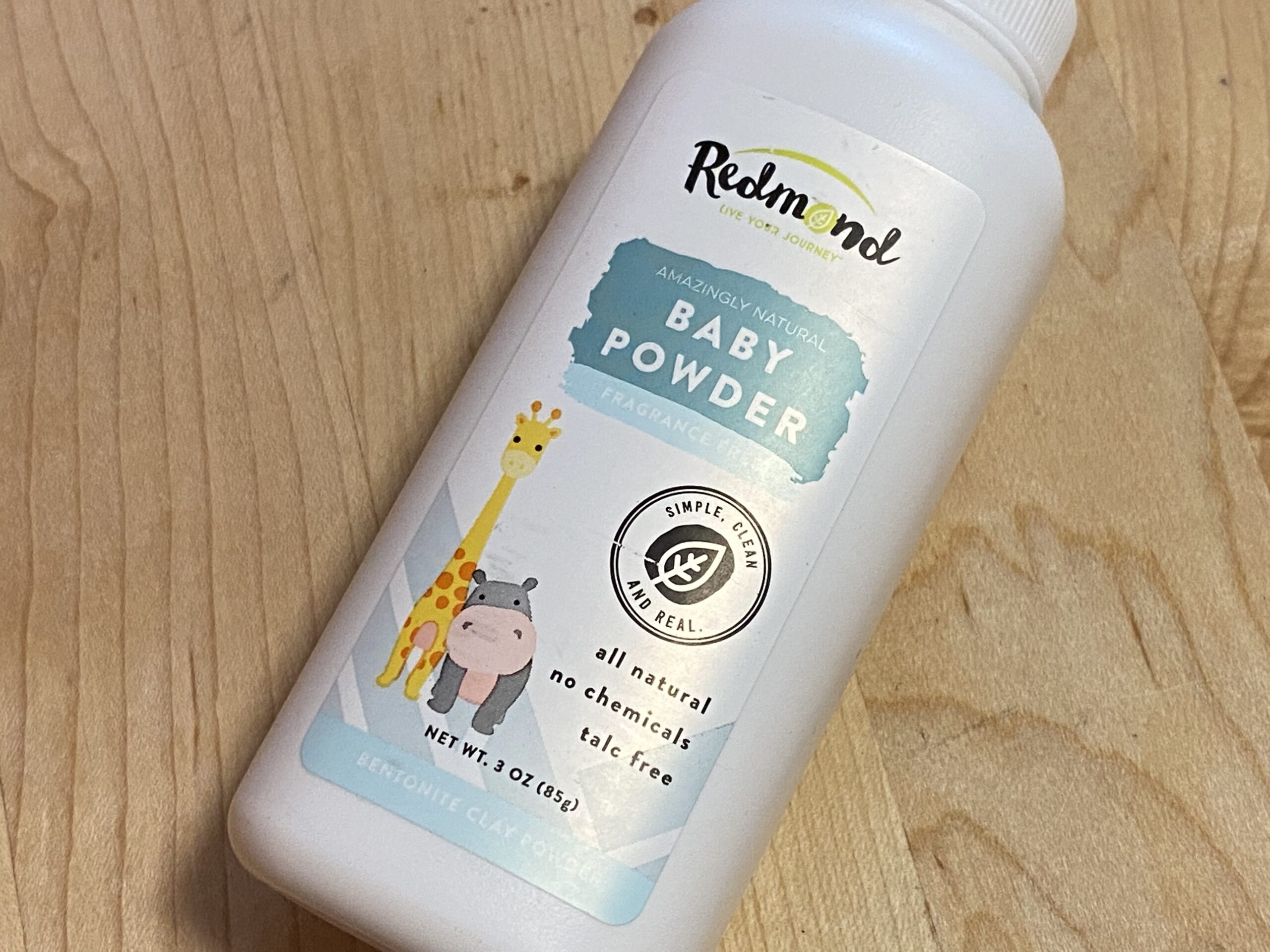
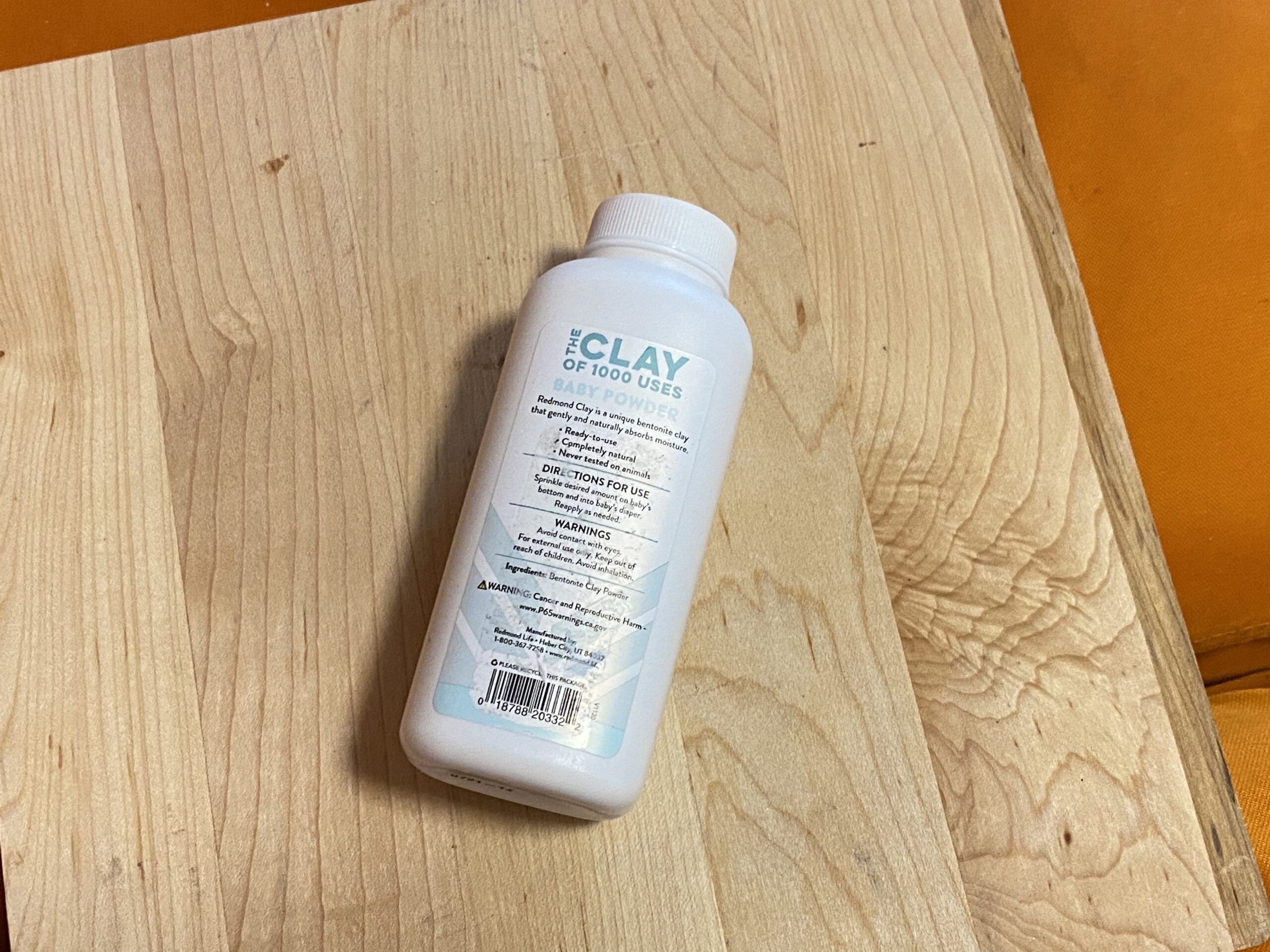
Never Miss an Important Article Again!
Join our Email List


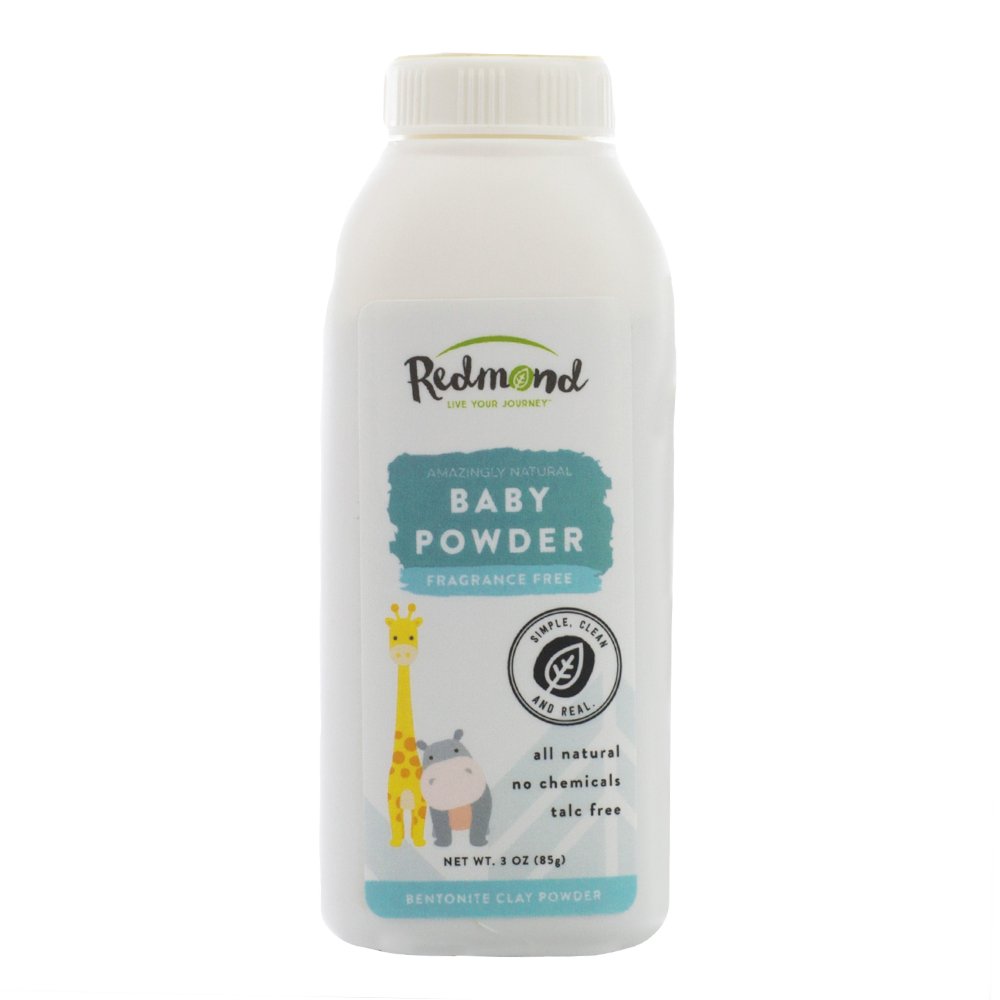
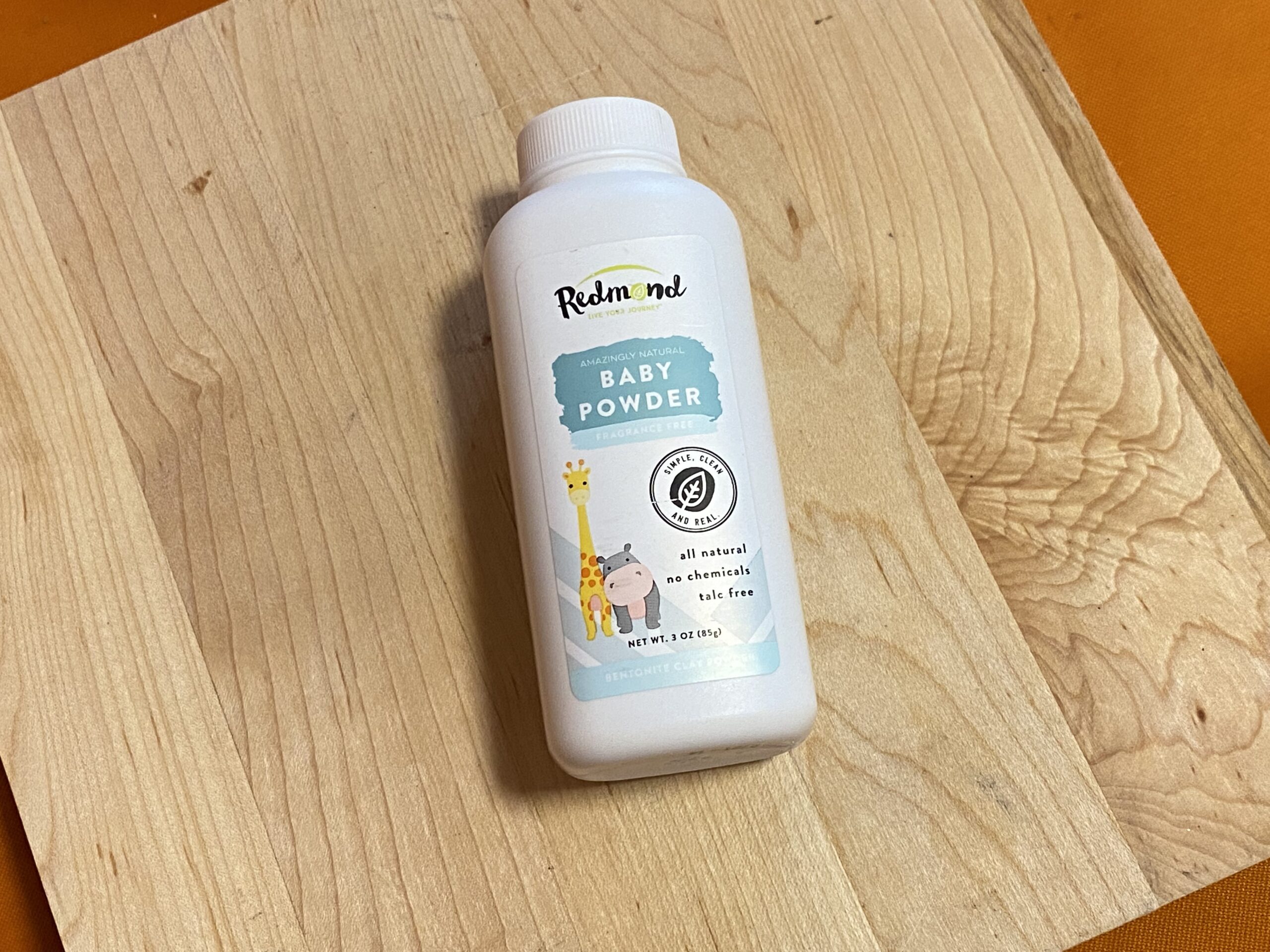
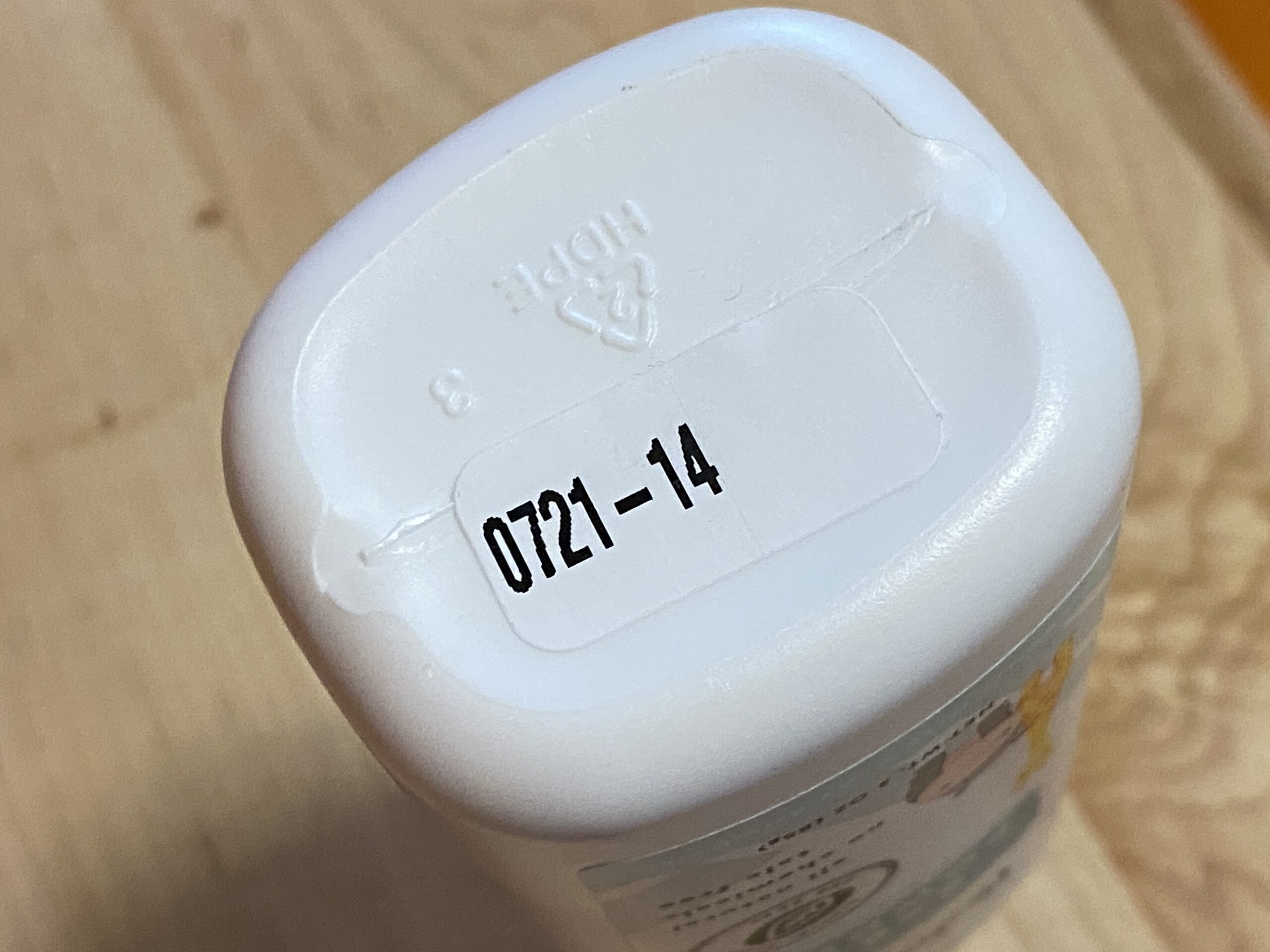



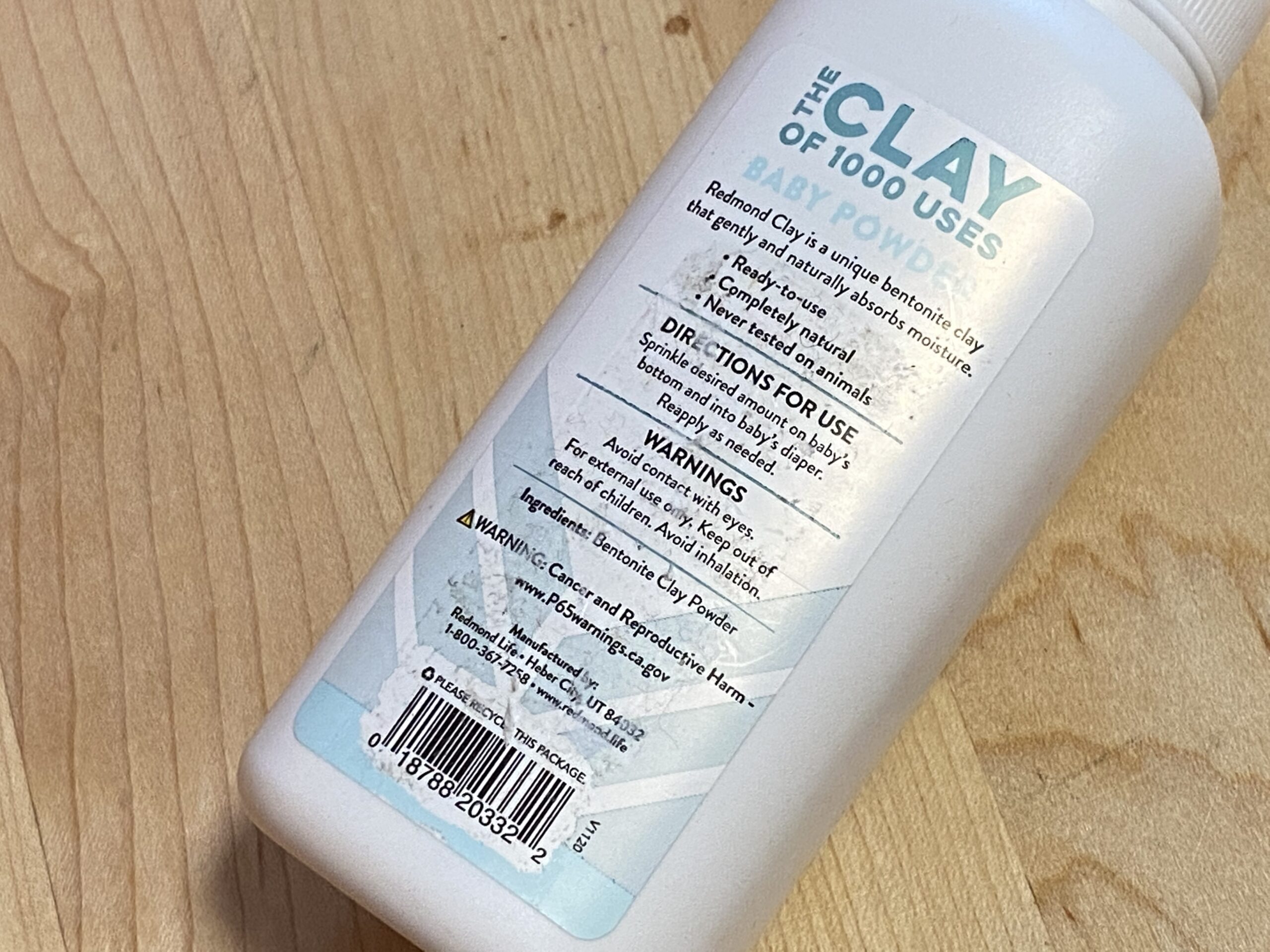
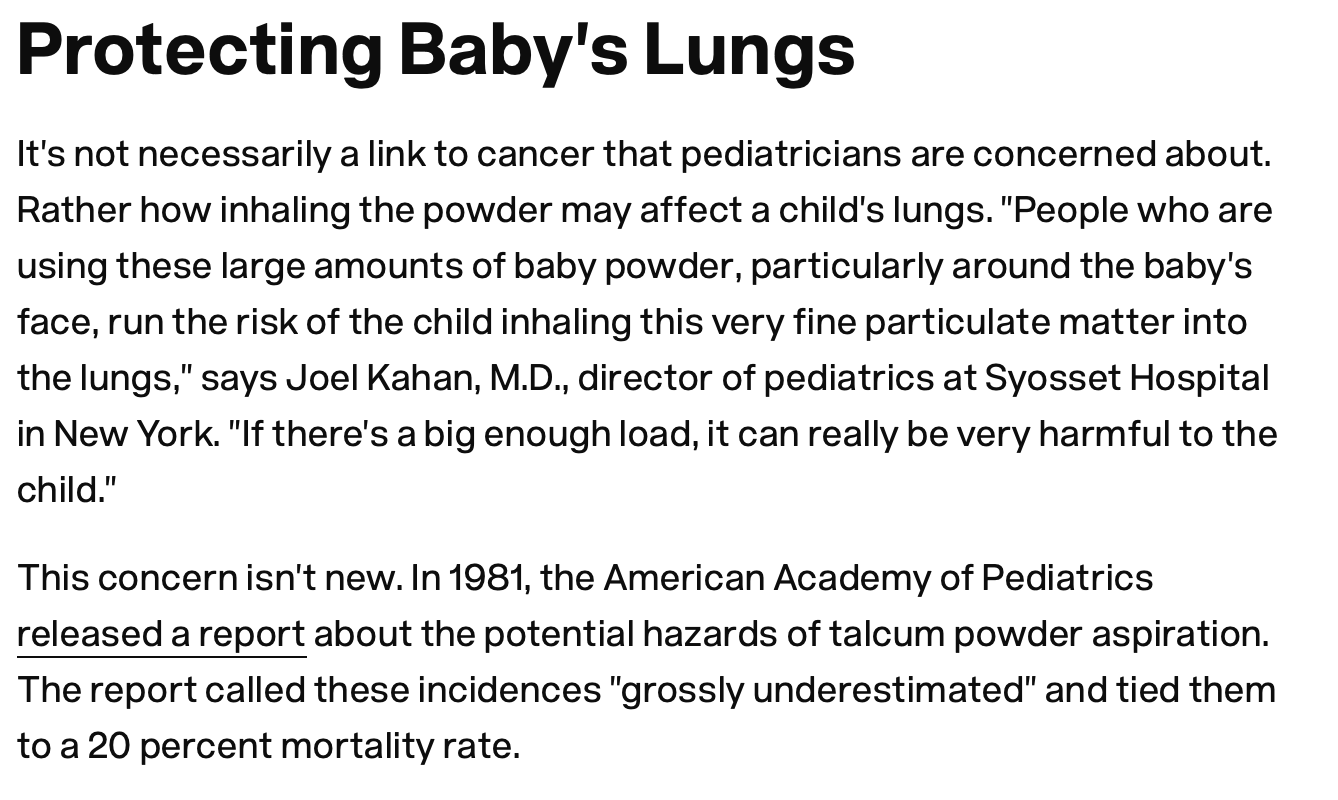
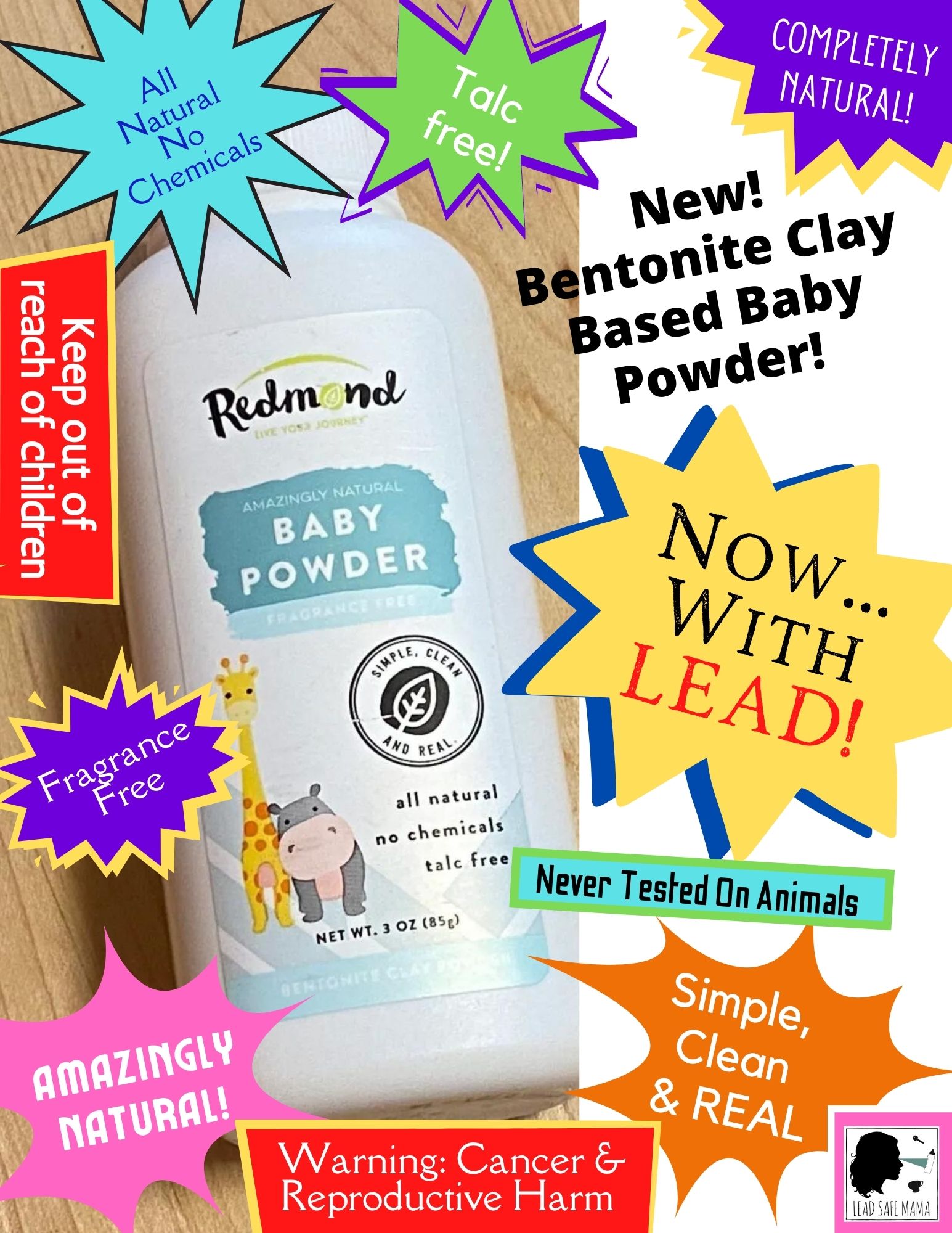
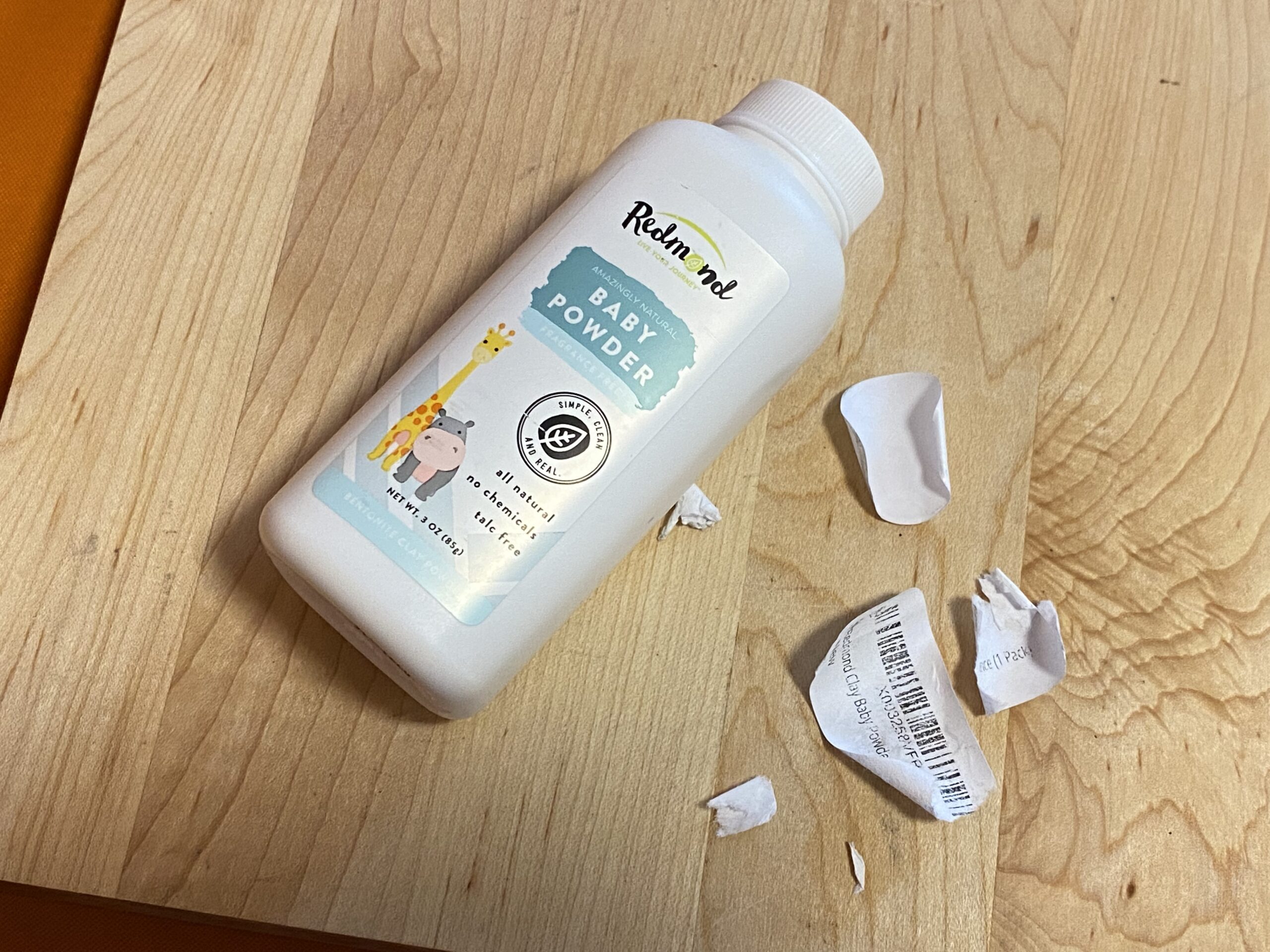

Hey Tamara,
Which lab are you mailing the samples to? I was looking for a lab for this purpose too
Hi Chi,
Tamara tested the samples using an XRF instrument.
I’m amazed that ANY powder is still used on babies! I realized with my first baby in 1980 that it was too easy to get the fine dust in the air where she (or I) could inhale it.
Yeah I never use powder but I use lotions for excema and baby eats a lot of it (even wipe it into his mouth) I no use coconut oil but baby us a year old so I worry. I tried to stick with the healthiest options but it’s really a challenge these days with green washing. For instance, I used Waleda diaper rash cream because the pediatrician recommended diaper rash cream for the zinc and Waleda has the European standards do I thought “ok their standards are higher” well after months of using it saw that ewg rates it as like a 9 (bad!) So then I usedHonest Organic All Purpose balm but he loves eating that (he will chase my finger with his mouth) so now I’m using coconut oil which I should have used since day 1but the doctors are always dismissive of something so basic but I figure food grade is safest since he eats the damn stuff…. God I hope I haven’t been giving him toxic stuff.
Lots of typos… sry
Can’t go wrong with coconut oil!!
Is this the same Redmond that makes the Redmond’s Salt?
Thanks for all you do Tamara!
It sure is! https://tamararubin.com/2021/02/redmond-asked-me-where-i-came-up-with-the-167-ppb-lead-result-for-their-real-salt-product-click-through-to-read-my-response/
Incidentally I was looking for a new toothpaste tonight on Amazon and they’re still selling it on there. I want to cry with how many people say it’s not toxic and give it to their kids! I don’t know if all these parents honestly didn’t see the warning or they don’t take it seriously, but for the sake of those children this company needs to be shut down!
I’m so disgusted with this company! I fell for their lies for years unfortunately and now I want to help others learn the truth (especially moms that think they’re using something safe for their child). To this end, I propose we as a community start commenting on all their social media posts with links to this information. I have already started on instagram. Let’s get this information out there so people can make informed choices.
They also have super high fluoride levels in their Real Salt products, 13.8 PPM of Fluoride, INSANE
Is there any bentonite clay that does not have lead?
They all test positive either for unsafe levels of Lead, Antimony or Cadmium.
Oh no! I’ve been using this baby powder since 2019. It really does help on stubborn rashes.
Could you please recommend an alternative?
Thank you!!
Please get a Blood Lead Test for your baby immediately.